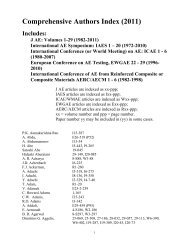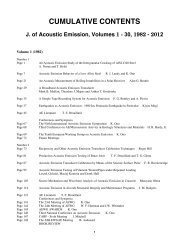Journal of AE, Volume 23, 2005 (ca. 43 MB) - AEWG
Journal of AE, Volume 23, 2005 (ca. 43 MB) - AEWG
Journal of AE, Volume 23, 2005 (ca. 43 MB) - AEWG
Create successful ePaper yourself
Turn your PDF publications into a flip-book with our unique Google optimized e-Paper software.
Based on the results in Table 6, we note that the ranking in Table 5 (at a certain propagationdistance) <strong>of</strong> the best to worst SD for each frequency and mode generally correlates with theamount <strong>of</strong> relative dominance <strong>of</strong> that frequency/mode regardless <strong>of</strong> the propagation distance. Forexample at 60 mm, the best SD for <strong>ca</strong>se 9034 has a strong dominance for the 60 kHz/A 0 mode(4.3, see Table 6), and the worst SD for <strong>ca</strong>se 9002 is actually dominated by the 522 kHz/S 0 mode(1.3, see Table 6). Table 6 also provides a reason for the SD ranking (in Table 5) changing withthe propagation distance. The increase in 60 kHz/A 0 mode dominance (see Table 6) with increasingdistance correlates with the observation that at the larger propagation distances the 60kHz/A 0 mode generally has the best SDs, except for one <strong>ca</strong>se (we ignore <strong>ca</strong>se 9002 since bothmodes have about the same peak magnitude). The results for <strong>ca</strong>se (2791) rank as one <strong>of</strong> the bestat all the propagation distances due to the fact that the dominance <strong>of</strong> the 522 kHz/S 0 mode is verystrong since there is no A 0 mode for this midplane source.A question arises, why are the 522 kHz/S 0 mode results the best at the 60 mm distance eventhough there are two 60 kHz/A 0 <strong>ca</strong>ses (9034 and 9004) with strong dominance? The answer tothis question is likely due to the “spreading in time” <strong>of</strong> the WT results at lower frequencies. The“spreading in time” terminology refers to the signal at a specific time contributing to the WTmagnitudes over a range in time about that specific time. This characteristic at lower frequenciesis illustrated in Fig. 5. In this figure the input signal to the WT is a Dirac delta function. Thus wesuggest the 60 kHz/A 0 mode WT peak magnitude arrival time has larger errors since the WTpeak magnitude in that <strong>ca</strong>se reflects a wider time-range <strong>of</strong> the noise signal (see Fig. 5). In contrast,the 522 kHz/S 0 mode WT magnitude does not have the same range <strong>of</strong> arrival time errorsbe<strong>ca</strong>use the WT peak magnitude at that frequency does not result from as wide a time range <strong>of</strong>the noise signal. At the longer propagation distances, the drop in the dominance <strong>of</strong> the 522kHz/S 0 mode is evidently sufficient to allow the higher magnitude noise in the region <strong>of</strong> 522 kHz(see Fig. 2) to increase the SDs. This results in the 60 kHz/A 0 mode SDs being generally thelowest at the longer distances.9. Relative Fall-<strong>of</strong>f <strong>of</strong> the 522 kHz/S 0 Mode with Increased Propagation DistanceThe 522 kHz/S 0 mode falls-<strong>of</strong>f at a faster rate than the 60 kHz/A 0 mode with increasingpropagation distance as is shown in Table 6. Since the finite element modeling results did notincorporate the available frequency-based attenuation with propagation distance, the source <strong>of</strong>this frequency/mode fall-<strong>of</strong>f is <strong>of</strong> interest. Since the frequency band is only 3 kHz wide in theWT computation, there should not be much dispersion with increasing propagation distance. Tocheck this assumption, the pr<strong>of</strong>ile <strong>of</strong> the WT magnitude (at each <strong>of</strong> the two frequencies) as afunction <strong>of</strong> time was plotted for one <strong>of</strong> the <strong>ca</strong>ses (<strong>ca</strong>se 9002, noise-free signal) at the threepropagation distances. The normalized results in Fig. 6 show some potential dispersion for the522 kHz/S 0 mode. For example, at 60 % <strong>of</strong> the peak magnitude <strong>of</strong> the 522 kHz pr<strong>of</strong>ile (in thelargest magnitude peak region) the width <strong>of</strong> the pr<strong>of</strong>ile increases by 50 % as the propagationdistance increases from 60 mm to 180 mm. On the other hand, the change <strong>of</strong> width over thosepropagation distances at this level was not perceptible for the 60 kHz mode. It is suspected thatthis fall-<strong>of</strong>f <strong>ca</strong>n be attributed to the following observations. In the 522 kHz region <strong>of</strong> the S 0mode, the group velocity curve makes nearly a “U-turn” (see Fig. 1 in reference 1) in the groupvelocity direction over a limited range <strong>of</strong> frequency change. Thus a range <strong>of</strong> frequencies in thisregion have about the same group velocity. This feature, in combination with the characteristic <strong>of</strong>the WT described next, likely <strong>ca</strong>uses this attenuation.11








